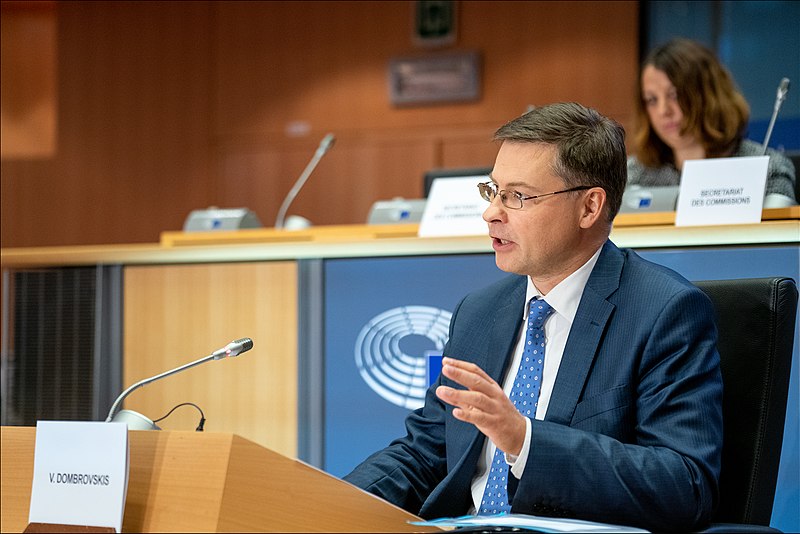
Good afternoon, ladies and gentlemen.
The EU economy is holding up remarkably well in a challenging and uncertain environment, with Russia continuing its brutal aggression against Ukraine. Our spring forecast upgrades the EU's growth outlook to 1.0% this year.
Energy prices have fallen significantly, and a strong labour market with record-low unemployment has helped to strengthen our economic resilience.
However, while headline inflation continues declining, core inflation is proving more persistent.
This hits people's purchasing power, especially in lower and middle-income groups, and hurts the competitiveness of EU companies.
All in all, at this critical time, it is vital for the EU to coordinate its economic and employment policies effectively.
Our principal guide for doing so is the European Semester, with its pillars of macroeconomic stability, fairness, environmental sustainability and productivity.
Today's package includes a focused recommendation for each country, which concerns:
- fiscal policy
- the implementation of the Recovery and Resilience Plans
- energy policy, so that Member States finalise the REPowerEU chapters in their RRPs
- outstanding or newly emerging challenges, with a focus on competitiveness and productivity as part of the green and digital transitions, as well as social resilience.
For the first time since we activated the general escape clause in March 2020, we have included quantified recommendations on fiscal policies.
As you know, the European Commission recently proposed new fiscal rules for the EU, and we hope to have them in place next year. In the meantime, the current rules continue to apply.
Therefore, the recommended fiscal efforts are centred around the benchmark of 0.5% of GDP.
But today's guidance also reflects the spirit of our new rules, in that the fiscal effort takes into account each country's challenges regarding debt sustainability.
Countries with more substantial challenges must adjust more than countries which face lesser challenges.
This should lead to a prudent fiscal policy that is consistent with the aim of reducing inflation.
As a first step, this means that Member States should wind down the support measures related to the energy price shock.
And to be clear: these savings should be used for reducing deficits – not for more spending.
Countries should also continue to prioritise investment, especially for the green and digital transitions.
Given the uncertainty around the macroeconomic outlook, the Commission does not intend to open new excessive deficit procedures at this stage.
However, we will propose opening deficit-based EDPs in spring 2024.
Member States should bear this in mind while carrying out their 2023 budgets and preparing their budgets for next year.
A word here on Romania, the only country under an excessive deficit procedure.
Since Romania's deficit in 2022 was in line with the target set by the Council, the procedure is kept in abeyance. Still, there are risks for both 2023 and 2024 that require more action.
As I mentioned, this year's guidance has a strong link to the Recovery and Resilience Facility.
We are now in a key phase of putting national plans into effect, with more than €150 billion disbursed.
However, we see that some countries face risks of delays to their implementation calendars.
Our recommendations call on Member States to steadily continue – and in several cases to accelerate - implementation of their RRPs.
It is also essential for Member States to finalise their REPowerEU chapters.
This will unlock funding to address the EU's energy security challenges and accelerate our shift to a net-zero economy.
The RRF also plays a vital role in making sure that the principles of the European Pillar of Social Rights are enacted and respected across all Member States.
This brings me to the social aspects of the spring European Semester package.
I mentioned the threat that inflation brings to people's purchasing power and to increasing poverty.
To mitigate these risks, we not only have to continue to tackle high inflation, but also make sure that the EU's social security systems are sufficiently strong, agile and efficient.
It is essential to close gaps in access to adequate and sustainable social protection and social inclusion systems.
Moreover, achieving fair green and digital transitions and safeguarding the EU's competitiveness will require future-proof social and labour market policies. This is why today's recommendations focus on education and training.
I will turn now to macro-economic imbalances.
Overall, we can say that imbalances are receding.
While public and private debt levels increased during the Covid-19 pandemic, they are now resuming their declining trend.
The banking sector is performing well.
However, risks related to high and diverging inflation rates could lead to losses in cost-competitiveness and external imbalances. We also see increased risks of house price corrections in some Member States.
Given the uncertainty, our approach on macroeconomic vulnerabilities has been prudent. We identified imbalances or excessive imbalances in 11 Member States.
Let me go into more detail. Hungary is found to have imbalances, with risks to the downside.
In Cyprus, the situation has improved – so its imbalances are no longer considered excessive.
Germany, Spain, France, Portugal, Romania, Sweden and the Netherlands are still experiencing imbalances.
However, for Germany, Spain, France and Portugal, imbalances are receding. And if these trends continue next year, there would be grounds for a decision on no imbalances.
In Romania, risks are to the downside.
Finally, Greece and Italy continue to experience excessive imbalances, but their vulnerabilities appear to be receding.
These positive developments are also reflected in our post-programme surveillance documents for Ireland, Greece, Spain, Cyprus and Portugal – where we have reached a positive conclusion on their capacity to repay their debt.
I will conclude here, and pass the floor over to Paolo.
Thank you.
Photo by European Parliament from EU, Wikimedia commons.



































